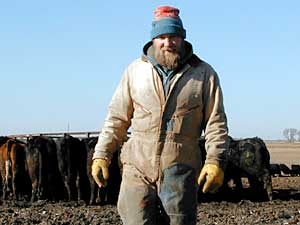|
Audio
Photos
More from MPR
Resources
Your Voice
|
Farmers made money in 2003
April 25, 2004
 |
| David Ourada at work on his southwest Minnesota farm near Lucan. He raises corn, soybeans, alfalfa, small grains and cattle. (MPR Photo/Mark Steil) |
Lucan, Minn. — Big or small, it didn't seem to make any difference in 2003. Nearly all farmers made money. The Minnesota State University study showed farm profits were 20 percent higher than the year before.
 | |||
The lowest ranked farms in the study earned about $21,000, the most profitable about $150,000. The farm economy was strong all across the nation. "It was the best year ever," says Keith Collins, chief economist with the U.S. Agriculture Department. "In 2003, $63 billion in net cash farm income was an all-time record high. It was a very strong year."
The reason for the good times were commodity prices. Farmers were amazed at what the local slaughterhouse or grain elevator was willing to pay. Beef prices rose so high that cattle rustling made a comeback. The normally pale yellow soybean seemed to take on the luster of gold.
USDA economist Collins says the heart of the farm boom lies in international trade. He says world food demand is rising.
"The result has been very strong exports for the United States," says Collins. "Plus we have some key markets that are just going very strongly, such as China."
Collins says meat is a popular item. That pushes up prices for livestock and livestock feed, things like corn and soybeans. Another factor helping U.S. farmers is poor crop yields in other countries. A big reason soybeans recently topped $10 per bushel is because Brazil's bean crop was damaged by weather and disease.
 | |||
The upward price spiral is something that reaches into the business nook of every Minnesota farm. The state university study showed all parts of the farm economy had a good 2003 -- grain, livestock, dairy.
Al Brudelie of Minnesota West Community and Technical College in Jackson helped put the study together. Dry weather hurt some farms last year, but higher prices eased the losses. Brudelie says some prices rose to record highs.
"Beef had a fantastic year," says Brudelie. "In southwest Minnesota, our beef was probably one of the shining enterprises that we had."
Farmers are happy with the good economic news -- but wary at the same time. They know the good times can't last forever. It's a little like a warm day in January -- a change in the wind can be brutal.
"You're waiting for things to drop," says David Ourada, who farms near Lucan in southwest Minnesota.
"So you try to get the best out of it that you can, and try to capitalize on the opportunities that are there at this moment," says Ourada. "And hope that you can survive the next downside, I guess."
 | |||
Ourada has seen just how quickly things can change. The cost of fuel is going up right now, and that will hurt Ourada's bottom line. They affect everything from gas and oil for the tractors to fertilizer.
And those record cattle prices? They disappeared overnight when mad cow disease was discovered in one animal last December in the northwest part of the country.
"I was actually just getting out of bed in the morning, then I heard it," says Ourada. "It kind of takes the fun out of it I guess, and you kind of wonder if things are actually going your way as much as you thought they were."
The mad cow price drop only lasted a couple of months, then cattle prices started rising again. The quick recovery is one factor pointing to another good year for farmers in 2004.
Grain prices are still at very profitable levels. They could push higher if dry weather develops. Milk prices may set a record, something consumers have noticed when they visit the grocery store.
Farmers appreciate the profits, but wonder how long they'll continue. For them, it seems the good times never last as long as the bad.
|
News Headlines
|
Related Subjects
|
